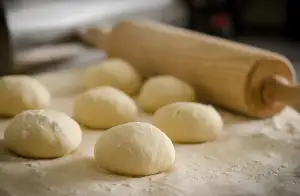Spice up Your Kitchen with a Flavorful Crab Boil Recipe: A Seafood Delight That Will Leave You Craving for More!

- History and Origins of Crab Boil
- Essential Ingredients for a Crab Boil
- Step-by-Step Guide to Cooking Crab Boil
- Preparing the Crab
- Preparing the Seasonings
- Boiling the Crab
- Cooking Time and Temperature
- Tips and Tricks for a Perfect Crab Boil
- Choosing the Right Crab
- Seasoning Variations
- Serving Suggestions
- Health Benefits of Crab
Crab boil is a mouthwatering seafood dish that has gained popularity for its bold flavors and unique cooking method. This delectable dish involves boiling fresh crabs in a flavorful broth, infusing them with a tantalizing blend of spices and seasonings. The result is a succulent and aromatic feast that will leave you craving for more. Whether you're hosting a backyard gathering or simply looking to indulge in a seafood delight, crab boil is the perfect choice to spice up your kitchen and satisfy your taste buds. In this article, we will explore the history, essential ingredients, step-by-step guide, tips, health benefits, and serving suggestions of this delightful dish. Get ready to embark on a culinary adventure as we dive into the world of crab boil!
History and Origins of Crab Boil
The history of crab boil can be traced back to the Southern United States, particularly Louisiana. It is believed to have originated from the traditional Cajun and Creole cuisines. The Cajuns, descendants of French-speaking Acadians who settled in Louisiana, brought their rich culinary traditions with them, including the concept of boiling seafood.
Crab boil became popular in the late 19th century as a way to cook and enjoy fresh seafood. It was initially a communal meal enjoyed by families and friends, often prepared outdoors in large pots over an open fire. The tradition of gathering around a table filled with steaming crabs and indulging in a messy but satisfying feast quickly caught on.
Over time, crab boil has evolved into a beloved culinary tradition that extends beyond Louisiana. Its popularity has spread across coastal regions where fresh seafood is abundant. Today, it is not uncommon to find variations of crab boil recipes in different parts of the world, each with its own unique blend of spices and seasonings.
The origins of crab boil reflect the cultural diversity and love for seafood that define many coastal communities. It continues to be cherished as a flavorful and festive way to celebrate good food and good company.
Essential Ingredients for a Crab Boil
To create a flavorful and satisfying crab boil, you will need the following essential ingredients:
1. Fresh Crabs: Choose live crabs that are heavy for their size, indicating they are full of meat. Blue crabs or Dungeness crabs are popular choices for a crab boil.
2. Seasonings: The key to a delicious crab boil lies in the seasoning blend. Essential spices include bay leaves, whole black peppercorns, mustard seeds, coriander seeds, cloves, and dried red chili flakes.
3. Vegetables: Enhance the flavors by adding vegetables such as onions, garlic cloves, celery stalks, and lemons to the boiling pot.
4. Salt: A generous amount of salt is necessary to season the water and infuse flavor into the crabs.
5. Optional Additions: Some variations may include additional ingredients like whole cobs of corn, smoked sausages, or baby potatoes to make it a heartier meal.
By gathering these essential ingredients, you'll be well on your way to creating an enticing crab boil that will leave everyone craving for more!
Step-by-Step Guide to Cooking Crab Boil
a. Preparing the Crab: Start by cleaning the live crabs thoroughly, removing any dirt or debris. Rinse them under cold water and gently scrub their shells. It's important to handle them carefully to avoid getting pinched.
b. Preparing the Seasonings: In a large pot, combine water, salt, bay leaves, garlic cloves, lemon wedges, and your choice of spices such as cayenne pepper or Old Bay seasoning. Bring the mixture to a boil and let it simmer for about 15 minutes to infuse the flavors.
c. Boiling the Crab: Once the seasonings are ready, carefully add the cleaned crabs into the pot. Make sure they are fully submerged in the liquid. Allow them to cook for approximately 10-12 minutes until they turn bright red and their shells become firm.
d. Cooking Time and Temperature: The cooking time may vary depending on the size of the crabs. As a general rule of thumb, larger crabs will require more time to cook thoroughly. Ensure that the internal temperature reaches at least 145°F (63°C) to ensure food safety.
Remember to handle hot crabs with caution when removing them from the pot using tongs or a slotted spoon. Allow them to cool slightly before serving with your favorite dipping sauces or melted butter.
By following these simple steps, you can create a mouthwatering crab boil that will impress your guests and leave them craving for more!
Preparing the Crab
Before diving into the deliciousness of a crab boil, it's important to properly prepare the star of the show - the crab. Start by purchasing live or freshly caught crabs from a reputable seafood market. Live crabs should be lively and active, with no signs of discoloration or strong odors.
To prepare the crab for cooking, begin by rinsing them under cold water to remove any dirt or debris. Next, use a pair of kitchen shears to remove the eyes and mouth parts from the front of the crab's shell. This step is essential for both aesthetic purposes and ease of eating.
After removing the eyes and mouth parts, flip the crab over and locate its apron, which is a small triangular flap on its underside. Gently lift this flap and pull it off to expose the abdomen. Then, turn the crab back over and use your hands to separate its top shell from its body. Be careful not to break off any legs in the process.
Once you've removed the top shell, discard any innards or gills that you find inside. Rinse out any remaining debris under cold water. At this point, your crab is ready to be cooked in a flavorful boil that will enhance its natural sweetness and briny flavor.
By taking these steps to properly prepare your crab, you'll ensure that each bite is as enjoyable as possible. So roll up your sleeves and get ready to indulge in a seafood feast like no other!
Preparing the Seasonings
The key to a flavorful crab boil lies in the seasonings. The traditional blend of spices creates a tantalizing aroma and adds depth of flavor to the dish. Here's how you can prepare the perfect seasoning mix for your crab boil:
1. Old Bay Seasoning: This iconic blend of herbs and spices is a must-have for any crab boil. It typically includes celery salt, paprika, black pepper, cayenne pepper, mustard powder, bay leaves, cloves, allspice, ginger, cardamom, and cinnamon.
2. Garlic: Fresh garlic cloves add a pungent and aromatic flavor to the boil. Crush a few cloves or mince them finely to infuse the seasoning mixture.
3. Lemon: The bright citrusy notes of lemon complement the sweetness of the crab meat. Squeeze fresh lemon juice into the seasoning mix or add lemon slices during boiling for an extra zing.
4. Onion: Chopped onions provide a savory base for the seasonings. They add depth and complexity to the overall flavor profile.
5. Red Pepper Flakes: For those who enjoy some heat in their seafood dishes, red pepper flakes are an excellent addition. They give a spicy kick without overpowering the delicate flavors of the crab.
6. Bay Leaves: These aromatic leaves impart a subtle herbal note to the boil. Add a couple of bay leaves to enhance the overall fragrance.
To prepare the seasonings, simply combine all these ingredients in a bowl and mix well until they are evenly distributed. Adjust the quantities according to your taste preferences – if you prefer spicier flavors, increase cayenne pepper or red pepper flakes; if you like it milder, reduce their amounts accordingly.
Once you have prepared your seasoning mix, it's time to move on to boiling your crabs and infusing them with these delightful flavors!
Boiling the Crab
Once you have prepared the seasonings and your crab is cleaned, it's time to start boiling. Fill a large pot with water, making sure there is enough to fully submerge the crab. Add the seasonings to the water and bring it to a rolling boil.
Gently place the crabs into the boiling water, ensuring they are fully submerged. Be careful not to overcrowd the pot as this can affect cooking time and evenness. Allow the water to return to a boil and then reduce the heat slightly to maintain a steady simmer.
Cooking time for crabs will vary depending on their size. As a general rule, allow around 10 minutes of cooking time per pound of crab. For example, if you have a 2-pound crab, cook it for approximately 20 minutes.
It's important to monitor the temperature of the water throughout the cooking process. Maintain a gentle simmer rather than a rapid boil, as this will ensure even cooking and prevent overcooking.
To check if your crab is cooked, carefully remove one from the pot using tongs or a slotted spoon. The shell should be bright red and firm when pressed. Additionally, you can insert a meat thermometer into one of the leg joints; it should read at least 145°F (63°C).
Once cooked, carefully transfer the crabs to a large platter or serving tray using tongs or gloves. Be cautious as they will be hot! Allow them to cool slightly before serving.
Boiling is an excellent method for cooking crab as it preserves its natural flavors while infusing it with delicious seasonings. With these simple steps, you'll have perfectly boiled crabs that are ready to be enjoyed!
Cooking Time and Temperature
Once you have prepared the crab and seasoned it to perfection, it's time to cook it to ensure that it is tender and flavorful. The cooking time and temperature are crucial in achieving the desired results.
To cook the crab boil, bring a large pot of water to a rolling boil. Add the seasoned crab to the pot carefully, making sure not to overcrowd it. It is important to maintain a consistent boiling temperature throughout the cooking process.
The general rule of thumb for cooking crab is to allow 10-12 minutes per pound of crab. However, this can vary depending on the size and type of crab you are using. It is always recommended to check the specific cooking instructions for your particular type of crab.
Maintaining a steady boil is essential for even cooking. If the water stops boiling when you add the crabs, wait until it returns to a boil before starting the timer. Keep an eye on the pot throughout the cooking process, adjusting the heat if necessary to maintain a gentle but steady boil.
Overcooking can result in tough and rubbery meat, while undercooking may leave you with raw or undercooked crab. To ensure that your crab is cooked perfectly, test one leg by pulling it gently. If it comes away easily from the body without any resistance, your crab is ready.
Once cooked, remove the crabs from the pot using tongs or a slotted spoon and transfer them to a platter lined with paper towels. This will help absorb any excess moisture.
Remember that these guidelines are just a starting point, as different recipes may require slight variations in time and temperature. It's always best to follow specific recipe instructions or consult reputable sources for precise cooking times and temperatures based on your chosen recipe.
Mastering the perfect cooking time and temperature for your crab boils will elevate your culinary skills and ensure that every bite is succulent and full of flavor.
Tips and Tricks for a Perfect Crab Boil
a. Choosing the Right Crab: Opt for live crabs that are active and have a hard shell. Look for crabs that feel heavy for their size, indicating they are meaty. Blue crabs and Dungeness crabs are popular choices for crab boils.
b. Seasoning Variations: Experiment with different seasonings to add variety to your crab boil. Traditional Cajun spices like cayenne pepper, paprika, garlic powder, and onion powder work well. You can also try adding Old Bay seasoning or a blend of herbs like thyme, bay leaves, and parsley.
c. Serving Suggestions: Serve your crab boil with melted butter for dipping the succulent meat. Add some lemon wedges for a tangy twist. For a complete meal, consider adding corn on the cob, potatoes, and sausages to the boil.
Remember to adjust the seasoning according to your taste preferences and spice tolerance level. Enjoy this seafood delight with family and friends!
Choosing the Right Crab
When it comes to choosing the right crab for your boil, there are a few factors to consider. First and foremost, you want to make sure you're using fresh, high-quality crab. Look for crabs that are alive or freshly cooked, with a vibrant shell and a pleasant oceanic smell.
There are several types of crabs that work well in a boil, including Dungeness, blue crabs, snow crabs, and king crabs. Each variety has its own unique flavor and texture, so choose based on your personal preference.
If you're looking for sweet and tender meat, Dungeness crab is an excellent choice. Blue crabs have a slightly briny flavor and delicate meat that pairs well with bold seasonings. Snow crabs have a mild taste and are known for their long legs filled with succulent meat. King crabs have rich and flavorful meat that is perfect for special occasions.
Size is another consideration when selecting crabs for your boil. Larger crabs will have more meat but may require longer cooking times. Smaller crabs cook faster but yield less meat. Consider the number of guests you're serving and how much crab you want per person when deciding on the size.
Lastly, if sustainability is important to you, look for crab that has been sourced responsibly. Check labels or ask your fishmonger about the origin of the crab to ensure it comes from sustainable fisheries.
By choosing the right crab for your boil, you'll enhance the overall flavor and enjoyment of this seafood delight.
Seasoning Variations
One of the great things about a crab boil is that you can customize the seasonings to suit your taste preferences. While traditional crab boils typically include ingredients like Old Bay seasoning, garlic, and lemon, there are endless possibilities for adding unique flavors to your dish.
For those who prefer a spicier kick, consider adding cayenne pepper or red pepper flakes to the seasoning mix. This will give your crab boil a fiery heat that is sure to awaken your taste buds.
If you're looking for a more aromatic flavor profile, try incorporating herbs such as thyme, rosemary, or bay leaves into the seasoning blend. These herbs will infuse the crab with a fragrant and earthy taste that complements its natural sweetness.
For a tangy twist, experiment with citrus fruits like oranges or limes. Squeeze their juices into the boiling water or add slices of these fruits to enhance the overall flavor of the crab.
Don't be afraid to get creative with your seasonings and experiment with different combinations. You can even try incorporating other spices like paprika, mustard seeds, or even ginger for an unexpected flavor burst.
Remember to adjust the quantities of each seasoning according to your personal preference and tolerance for heat. The beauty of seasoning variations is that you can tailor them to suit your individual taste buds and create a truly unique crab boil experience every time you cook it.
Serving Suggestions
Once you've prepared your flavorful crab boil, it's time to think about how to serve this delicious seafood delight. Here are some serving suggestions that will enhance the overall dining experience:
1. Family-style Feast: Serve the crab boil on a large platter in the center of the table, allowing everyone to dig in and enjoy. This communal style of serving creates a fun and interactive dining experience.
2. Cajun-inspired Spread: Accompany your crab boil with traditional Cajun sides such as corn on the cob, red potatoes, and Andouille sausage. These flavorful additions complement the spiciness of the crab boil and create a hearty meal.
3. Dipping Sauces: Offer a variety of dipping sauces to enhance the flavors of the crab meat. Classic options include melted butter, cocktail sauce, tartar sauce, or aioli. These sauces add richness and tanginess to each bite.
4. Fresh Citrus: Serve wedges of lemon or lime alongside the crab boil. Squeezing a little citrus juice over the cooked crab meat adds a refreshing burst of flavor that balances out the richness.
5. Crusty Bread: Don't forget to provide crusty bread or rolls for soaking up any remaining juices from the crab boil. The combination of tender crab meat and savory broth soaked into warm bread is simply irresistible.
Remember, presentation matters too! Arrange your cooked crabs neatly on a platter with garnishes like fresh herbs or sliced lemons for an eye-catching display that will impress your guests. Enjoy this seafood feast with loved ones and let them savor every moment!
Health Benefits of Crab
Crab is not just a delicious seafood delicacy, but it also offers numerous health benefits. Packed with essential nutrients, crab is a low-fat and high-protein food that can be a great addition to a healthy diet.
Firstly, crab is an excellent source of lean protein, which is essential for muscle growth and repair. A 3-ounce serving of crab provides around 16 grams of protein, making it an ideal choice for individuals looking to build or maintain muscle mass.
Additionally, crab is rich in omega-3 fatty acids, which are known for their heart-healthy properties. These fatty acids help reduce inflammation in the body and may lower the risk of cardiovascular diseases.
Crab also contains important vitamins and minerals such as vitamin B12, selenium, and zinc. Vitamin B12 plays a crucial role in maintaining nerve function and producing red blood cells. Selenium acts as an antioxidant and supports thyroid function, while zinc supports immune system health.
Furthermore, crab meat is low in calories and saturated fat compared to other meats like beef or pork. This makes it a healthier option for those watching their calorie intake or trying to maintain a balanced diet.
It's worth noting that while crab offers many health benefits, individuals with shellfish allergies should avoid consuming it. Additionally, moderation is key when enjoying crab due to its naturally high sodium content.
In conclusion, incorporating crab into your diet can provide you with valuable nutrients like protein, omega-3 fatty acids, vitamins B12 and minerals like selenium and zinc. So not only does it satisfy your taste buds but also contributes to your overall well-being.
In conclusion, a crab boil is not just a meal, but an experience that brings people together. Its origins can be traced back to the coastal regions of the United States, where it has become a beloved tradition. By using essential ingredients and following a step-by-step guide, you can create a flavorful and satisfying crab boil in your own kitchen. Remember to choose the right crab, experiment with different seasonings, and serve it with your favorite side dishes for a complete seafood feast. Not only is crab delicious, but it also offers numerous health benefits due to its high protein content and essential nutrients. So why not spice up your kitchen and indulge in this seafood delight? Your taste buds will thank you!
Published: 16. 02. 2024
Category: Recipes



